
views
Preparing To Write Your Letter

Brainstorm your ideas. Before you start your letter, brainstorm. Make sure it states what you want, why you want it, reasons why it should be granted, and any arguments against you. Is this really the topic you want? Getting your ideas down can help you clearly draft your letter and fully understand your position on the topic. Start by using this: I want to persuade my audience to my purpose. Exchange my audience with who you want to persuade and my purpose with what it is you want to persuade them to do. After you have established that, ask yourself: Why? List the reasons why you want your audience to do what you want them to do. After you brainstorm reasons, sort them by importance. Place all the important details into a column, then place all the less important details in another column. This step helps you narrow your reasoning so you emphasize the relevant, salient points.

Know your purpose. Make sure you know exactly what you want or need. What are you trying to accomplish? What do you want to happen? When you are figuring out your purpose, think about any solutions that you can offer.

Know your reader. Analyzing and understanding your audience will help you decide how you should frame your letter. If possible, determine if your reader agrees with you, disagrees with you, or is neutral. This will help you decide how much weight should be placed on each side of your argument. Try to find a real person to address your letter to. Who are they, and what power do they really have to help you? How are they going to change your mind? Will they just pass along your complaint? How should you address them? Are they in a senior or functionary position? Talk to them according to their position. Try to discover what beliefs and biases the reader has about your topic. What disagreements might arise between you and your reader? How can you present a counterargument respectfully? Figure out what concerns your reader might have with the topic. Do they have limited funds to distribute? Are they directly affected by the topic? How much time do they have to consider your document? Think about the kind of evidence your reader will need in your argument to be persuaded.

Research the topic. Effective persuasive letters contain factual evidence and information that supports the position. Make sure to consider multiple points-of-view. Don't just research your side; mention the contrary opinion and facts surrounded it. Use facts, logic, statistics, and anecdotal evidence to support your claim. Don't come out and say the other side is wrong; instead, be respectful as you explain why your position is stronger and deserves notice.
Formatting the Letter

Use block formatting. Business letters have a specific format. When done properly, the formatting won't sway your reader one way or another. However, if done improperly, the formatting will reflect badly on you and your reader may toss it aside. Start by using single-spaced, block paragraphs. Left justify each paragraph; in other words, don't indent the paragraph like you would in prose or an essay. Leave a line between each paragraph. Use a standard font, typically Times New Roman or Arial, in size 12.

Address the letterhead properly. Start by typing your address in the top left corner. Do not put your name - only type the street address, city, state, and zip code. You may also include a telephone number and an e-mail, each on separate lines. If you live in Britain, the address goes on the right side. Skip a line. Type the date. Spell out the name of the month, then give the date and year. Skip a line. June 4, 2013 Provide the name and address of the recipient. Try to find a specific person to send your letter to. Skip a line.
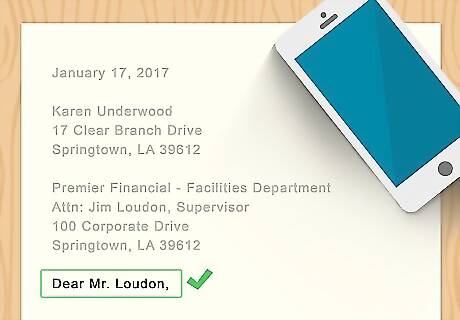
Start the letter with a salutation. Accepted practice is to start with the word Dear followed by the person's name. Make sure to spell the name correctly when you type it. The name should match the name in the letterhead address. When addressing the person, use their title (Mr./Ms./Dr./Miss/etc) and last name. If you are unsure what a woman's preference is, refer to her as Ms. Always follow this by a colon. Leave a line between the salutation and the first paragraph. Dear Dr. Brown:

Close the letter with a closing statement. Think about the tone of your essay when choosing a closing statement. Some things, like Thank you, are pretty standard, while others, like Best regards, are friendlier. Decide if your letter warrants a formal or friendly closing. No matter what you choose, the first word should be capitalized while the following words are not. Follow the closing statement with a comma. Choose Respectfully yours, for something more formal. Sincerely, Kind regards, Thank you, or Yours truly, are standard for formal business e-mails. Best, Best regards, or Have a nice day, are much less formal and friendly. Skip 4 lines afterwards to leave room for the signature before typing your name. Thank you,
Writing the Letter
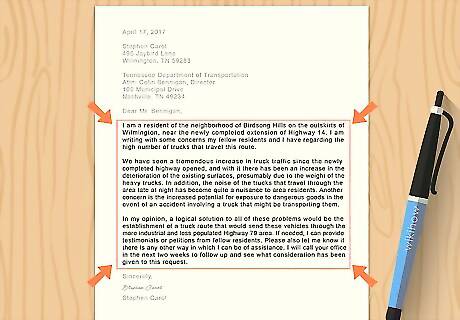
Be concise. Persuasive letters need to be brief and polite. Busy people seldom read such a letter if it's over a page or if the tone is nasty. Don't be overly wordy. Try to use clear, uncluttered sentences. Refrain from digressing and providing unnecessary information, asides, and anecdotes. Avoid overly long sentences. Make sure to use strong, declarative sentences. Your writing should be succinct, to the point, and easy to read. Don't make your paragraphs too long. Don't cram so much information inside that you lose your reader, stray from the main point, or make your point hard to understand. Stick to the relevant information, and change paragraphs when you start a new idea.

State your main point in the first couple sentences. Start with a friendly opening sentence, then get straight to the point. State your need (that is, your main point) in the first two sentences. This paragraph might only be 2-4 sentences.
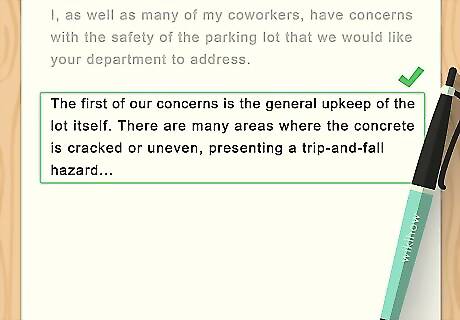
Emphasize the importance of your request in the second paragraph. In this paragraph, outline your concern, request, or demand. You are not giving specific reasons, support, or points yet; instead, you are fully explaining your position, the parameters of your concern or request, and why it is important enough to warrant action. Remember to keep it logical, polite, and factual. Avoid overly emotional language, don't demand action, or be rude to the person or company you are writing to or opposing sides.
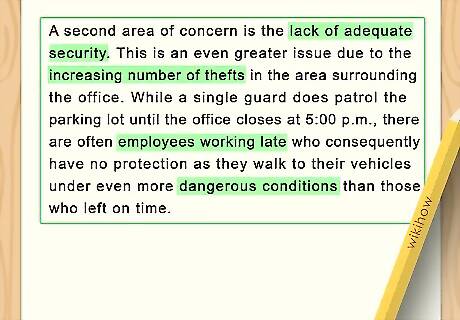
Support your request in the next paragraphs. The next few paragraphs should justify your position by providing background information and details. Make sure they are logical, factual, reasonable, practical, and legal. Don't base your appeal simply on emotions, faith, or personal desires. Don't bore the reader with a long story; get to the point quickly and accurately. There are a few different strategies you can employ to achieve this: Cite statistics and facts to appeal to your reader's reason. Make sure your statistics and facts are from credible, respected sources, and that you are using them truthfully and not taking them out of context. Make sure to cite the sources. Quote experts on the topic who support your position or disagree with the other side. These experts should be respected in their fields and be qualified to have an opinion on the subject. Provide a reason why your request should be granted. Telling someone they need to do something isn't a very effective persuasive technique, but explaining to them why you believe something should be done can help change their mind. Provide details, specifications, and limitations to your position and request. Talk about past efforts related to your request, or the lack of any action. Give examples of testimonials that relate to your position. Think of any other evidence you can provide as to why your position matters. Just remember to limit what you include in your paragraphs. State your case and situation simply. Don't go into excess detail, but do include all the essential points. Choose only the most relevant statistics, experts, and testimonials.
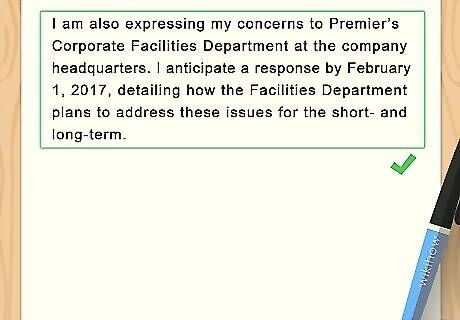
Appeal to the other side. One key to effective persuasion is to address the opposing side. You want to predict any counterarguments, objections, or questions your readers will have so you can address them in your letter. Find common ground with the opposition, or provide strong support for your own position. Make sure to openly admit differences between your position and the opposing side. Don't try to hide them; this weakens your argument. Instead, stress shared values, experiences, and problems with the opposing side. Avoid judgmental statements. That puts too much emotion into your letter and lessens your logical appeal. Being overly negative and judgmental may deter the other side from agreeing with you.
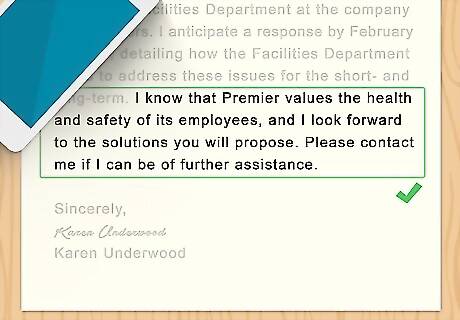
Close the letter by restating your request. Restate your request or opinion at the end. This is the paragraph where you can suggest a solution or call to action. Tell the reader that you will follow up on this correspondence by phone, email, or in person. Aim to end with a powerful sentence that will help to persuade your reader to be on your side, or to at least see things more clearly from your perspective. Offer your own solutions or help. Agree to compromise, or meet in the middle. Show what you have already done or are prepared to do to deal with the situation.
Putting on the Final Touches

Check for errors. Poor grammar and misspelled words give a bad first impression. You want the reader to focus on your ideas and your request, not the errors in your letter. Reread the letter multiple times before sending it. Read the letter aloud to hear how it sounds. If needed, have someone check your writing for spelling (or use your spell checker in the software).
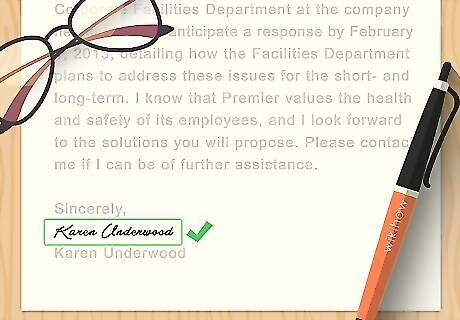
Sign with your own signature. If you are mailing the letter instead of sending an e-mail, then you need to sign the letter. This both personalizes and authenticates your letter.
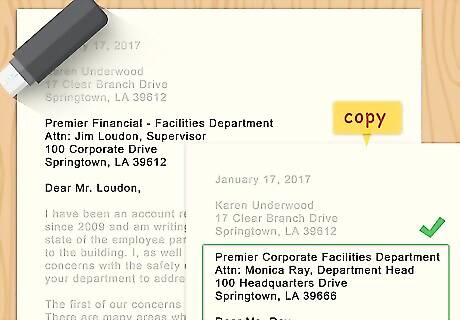
Copy other key people in a formal letter if needed. If there are other people in the company or at another organization that need to see the letter, send them a copy. This means printing and sending more than one letter, with original signatures.

Keep a copy yourself. Always keep a letter for your own records, along with when you sent the letter and who you sent it to. Write notes on your follow-up efforts until the matter is resolved.




















Comments
0 comment